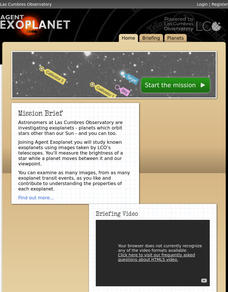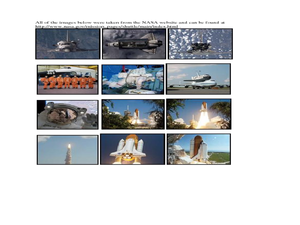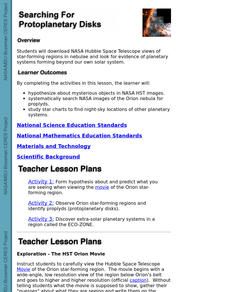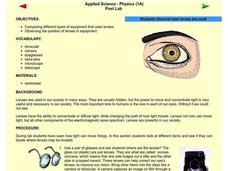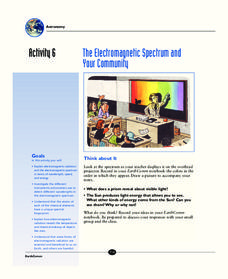Glynn County School System
Multi-Wavelength Astronomy
Take a look at astronomy through the light lens. From radio to gamma, light waves exist in every corner of the universe. An enlightening PowerPoint presentation gives an overview of the different categories of light and then discusses...
Fluence Learning
Writing About Informational Text: Beyond the Beyond—Galaxies
Everyone has a different point of view, even when it comes to the enormity of the universe. Two separate text passages explain the scope of a galaxy, prompting young readers to write an essay about each author's argument and how the...
PBS
Exoplanets through Kepler’s Laws
The majority of all confirmed exoplanets relied on Kepler's laws to discover their locations. Scholars learn how to apply Kepler's laws and then practice using data to discover exoplanets. They benefit from NASA video footage, NOVA...
Las Cumbres Observatory
Measuring the Age of the Universe
Just when is the universe's birthdate? Pupils use previously collected spectra data to find the redshift and radial velocity of supernovas. They then calculate the distance before finally creating a Hubble diagram. Finally, individuals...
Las Cumbres Observatory
Create a Hubble Tuning Fork Diagram
Add a little color to the universe. Learners recreate images of the galaxies using real data and Photoshop software. They display their images in a Hubble tuning fork diagram by classifying and categorizing their shapes.
Las Cumbres Observatory
Agent Exoplanet
Not everything revolves around the sun! Believe it or not, there are planets, called exoplanets, that orbit stars other than our sun. Learners use an interactive online resource to research several of these planets. They learn about the...
Academy of American Poets
Teach This Poem: "In the Next Galaxy" by Ruth Stone
Imagine what life might be like in a different galaxy. That's the challenge young scientists take on in a warm-up activity designed to prepare them for a close reading of Ruth Stone's poem "In the Next Galaxy." After class members share...
American Museum of Natural History
Being an Astronomer: Neil deGrasse Tyson
An interview delves deep into the life of famous astronomer Neil deGrasse Tyson.
American Museum of Natural History
Journey to the Stars
Fifteen detailed pictures and informative captions delve deep into the exploration of stars—their life cycle and importance in the universe.
Curated OER
Modeling a Planetary Nebula
In this modeling a planetary nebula worksheet, students use a diagram to calculate the intensity at different radii from the center of the nebula. Students use the Pythagorean Theorem to determine the distance between two points on the...
Curated OER
Hinode-Close Up of a Sunspot
In this solar sunspot worksheet, students use two photographs from the Hinode solar observatory showing a sunspot on the solar surface. Students solve 5 problems including finding the scale of the images, determining the smallest detail...
Curated OER
Best of the Solar System
Students visit a site which provides images to be analyzed. Notes are taken and planets are named based on observed features and observations. Using peer review, they try to determine the identity of the planets. They are free to browse...
Curated OER
Build a Space Shuttle
Students explore the concept of space. In this space lesson, students pretend to be aerospace engineers. Students build space ships out of cardboard tubes. Students discuss what aerospace engineers do. Students model their space ships...
Curated OER
Advanced Critical Reading: Hubble
In this critical reading worksheet, students read a passage about the Hubble Telescope and then answer seven questions based on the reading.
Curated OER
Searching For Protoplanetary Disks
Students download NASA Hubble Space Telescope views of star-forming regions in nebulae and look for evidence of planetary systems forming beyond our own solar system. They hypothesize about mysterious objects in NASA HST images.
Curated OER
Geometry of Radio Meteor Reflections
Ninth graders investigate and describe ways that human understanding of Earth and space has depended on technological development. They describe and interpret the science of optical and radio telescopes, space probes and remote sensing...
Curated OER
Prefixes
Read out loud the stories Doctors Try to Separate Joined Twin Sisters, and New Planets Discovered. Focus on these words and the meanings of their prefixes: conjoined, extra-solar, telescopes, and universe. Then read information on the...
Curated OER
Images of Science
Learners understand the diversity of science, both in terms of the work and the people engaged in the work. They learn that some scientists and engineers use huge instruments (e.g., particle accelerators or telescopes), and others use...
Curated OER
April 25th Writing Prompt
In this daily writing prompt worksheet, students learn that the Hubble Telescope was launched on April 25, 1990. Students comment on whether is it is beneficial to study the universe.
Curated OER
The Lesson: Space Exploration
Students explore space. For this current events lesson, students visit selected websites to learn about NASA, Mars, the Seti Institute, and space exploration terminology. Students make space glossaries and their own telescopes.
Curated OER
Lenses
Students explore vision by experimenting with lenses in equipment. In this optics instructional activity, students define the different technology that enhances vision such as microscopes, telescopes and cameras. Students experiment with...
It's About Time
The Electromagnetic Spectrum and Your Community
Do you have blossoming astronomers who seek to understand the electromagnetic spectrum? Assist them with exploring electromagnetic radiation and the electromagnetic spectrum as the class conducts various activities to demonstrate...
DiscoverE
Design a Folding Solar Panel
Solar energy is an amazing alternative ... but, not always particularly portable! Challenge young scientists to a folding solar panel build-off with an easy-to-execute activity. Scholars brainstorm around specific design needs, construct...
Las Cumbres Observatory
How Big is the Solar System?
Find out if it's possible to travel to the edge of the solar system. Learners use a piece of string to model the distance between planets in the solar system. They then use the distances to calculate how long it would take to travel to...
Other popular searches
- Space Telescopes
- Hubble Telescopes
- Compare Telescopes
- Optical Telescopes
- Reflecting Telescopes
- Making Telescopes
- Space Tools Telescopes
- Telescopes Distant Objects
- Telescopes Handout
- Optical and Radio Telescopes
- Convex Lenses and Telescopes
- Radio Telescopes







